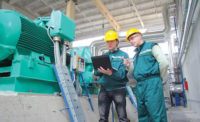Green manufacturing doesn’t have to involve solar power and wind turbines. It can be turning equipment to a lower setting when not in use, switching the lighting, or even changing a plant’s operating hours in order to save electricity.
University of California-Berkeley Professor David Dornfeld studies green manufacturing through his work as the chair of the Department of Mechanical Engineering and head of the Laboratory for Manufacturing and Sustainability, and he’s seen plenty of companies go through a greening process. One automaker was able to change the heat settings on equipment in their paint department. Others have found lighting changes have saved them money. Another time he worked with a Japanese company that decided to shift operating hours to save electricity that way.
He says a lot of people are aware of what could be done to minimize the environmental impact of their work, but not how to do it.
Getting Green
In the introduction of his book, “Green Manufacturing,” Dornfeld explains the importance—and inevitability—of considering the environmental impact: “If one relies on a global market for one’s products, as increasing numbers of organizations do, one will be faced with the demands of green manufacturing sooner or later.”
And many companies have already gotten involved in green initiatives. But in keeping with the ideas of continuous improvement, there are always more opportunities to reduce your environmental impact. In looking to make manufacturing operations more green, there are plenty of options: hiring a consultant, taking a class, reading about other successful companies. But often there is so much to do that it can seem overwhelming. An important step is to define goals and then measure them, which allows companies to track improvements. And with some business units serving as silos, it can help a facilities manager convince the accounting department of the need to invest in new technologies.
Even if a company has not taken green steps, it doesn’t mean they aren’t aware of what to do. Dornfeld worked with an automotive manufacturing company where an employee told him “you needed a shovel to handle the low-hanging fruit” because there were so many improvement opportunities. In this case, they considered the environmental impact and economic benefit of each project, the idea being to avoid those with little impact that cost a lot, Dornfeld says.
Beyond Recycling
Green manufacturing doesn’t just mean recycling materials. In fact, recycling comes after other options have been exhausted. Instead, manufacturers should refuse to create waste, reduce it, reuse resources, and then, finally, recycle. For those who want to learn more about green manufacturing, consider a program such as the SME-Purdue Green Manufacturing Specialist Certificate. Since the program began in May 2010, hundreds of people have gone through the training, from a range of companies and industries.
“Jobs don’t have to have a title with green to be green,” says Lori Ann Dick of SME. “Everybody’s job is to reduce waste.”
Kris Nasiatka, senior manager-certification, book & video and tooling U-SME, echoes this idea. “When the program came out, there was confusion about ‘what is green?”” But today, she says, manufacturers realize the potential for saving money with these types of initiatives.
The certificate program offers instruction on the green body of knowledge, compiled with the help of industry experts. According to Jon Guenin, lead sustainability specialist at Purdue’s Technical Assistance Program, who manages the green education program, the most popular module is energy, followed by solid waste and water. Air and toxicity have been more heavily regulated in the past, so these areas have already been tracked. “What we’re seeing more and more is companies want to start actively managing energy, water and solid waste,” Guenin says. “They aren’t usually doing that much other than tracking and budgeting. What we try to teach them is an approach, the same processes as lean, PDCA, plan-do-check-act … and incorporate it into the culture, much like we have with quality.”
That’s what Dan Burlinghaus of MTD Products did. His company began looking into sustainable practices in 2011. The Ohio-based outdoor power equipment manufacturer found the SME-Purdue program fit well with the culture of lean and continuous improvement, and examined the concepts of Refuse, Reduce, Reuse and Recycle.
When considering what it means to be green, Burlinghaus says, “People think recycling. But that’s number four on the list. The program opened up new way of looking at things.”
MTD Products worked through the acronym of WASTE, for water, air, solid waste, toxicity and energy. And then they began using this knowledge, specifically focusing on solids and energy. The company was already recycling cardboard boxes from one of their vendors. But recycling was still not ideal. They asked the vendor if they could collapse the boxes, which were still in good shape, ship them back and have the vendor reuse them. The vendor agreed, since they were going to buy new boxes anyway. In another instance, a vendor was shipping a bearing in a plastic sleeve, which caused extra labor on the line, cost money, and then just went to a landfill. They found a way to package the product without the sleeve.
In addition to these waste-reduction efforts, looking into ways to cut down on energy was also important to the company, as it is with many other manufacturing companies, which tend to be energy-intensive operations.
“Energy is the new kid on the block,” Nasiatka says. “How do we get people to look up, and see the heat lost in these processes and reduce the energy footprint?”
This isn’t an easy process—otherwise it would have been done long ago—but it is worth looking into for the potential cost savings.
Earning Money by Saving Energy
Dornfeld highlights the importance of saving energy, often one of the biggest costs for a company—“everybody and their dog is trying to do stuff with energy,” he says—and it can really help save money. As he writes in his green manufacturing blog, to paraphrase Ben Franklin, “A kilowatt saved is a kilowatt earned.”
This idea has been adopted throughout the country. In March, the Department of Energy announced a $23.5 million investment in clean energy manufacturing projects. And green power continues to attract attention. In April, the Environmental Protection Agency (EPA) released a list of the top 50 companies using electricity from clean, renewable sources, or “electricity produced from solar, wind, geothermal, biogas, eligible biomass, and low-impact small hydroelectric sources.” Intel Corp. topped the list, followed by Microsoft, Kohl’s Department Stores, Whole Foods Market, Wal-Mart Stores Inc., U.S. Department of Energy, Staples, Starbucks Company-Owned Stores, Lockheed Martin Corp., and Apple Inc.
But even without outside investment or wind power, manufacturers can still improve energy use, Dornfeld says. “The lowest hanging fruit is probably lighting—turn off lights and computers and office equipment—and then process related things such as the energy of machinery not in operation.” From there, companies can modify or install machinery to achieve a higher rate of productivity per unit.
The next level—though these levels can be done at the same time—would be organizational, to organize the flow of material through a facility. Dornfeld says a further option might be to adjust the production cycle, as with the Japanese company who moved the workday forward to take advantage of the reduced energy available after the Fukushima nuclear accident. (According to NPR, the Japanese word setsuden, meaning “energy-saving,” become popular after the accident.)
Creative, energy-saving options may be the future of manufacturing, as companies fight to stay competitive in a crowded marketplace.
“I think sustainable manufacturing practices are here to stay,” says Guenin. He cited the joke: “How do you know you’re an advanced manufacturing company? If you’re in business.”
And for those who want to stay in business, sustainable business practices can help companies improve. Guenin says, “If you don’t look at those costs, your competition will.”
|
TECH TIPS
|





